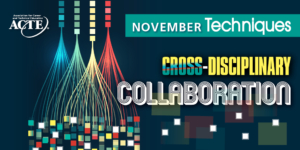Support student success & faculty retention
Research tells us that when students are engaged at school, they are 2.5 times more likely to excel and 4.5 times more likely to express hope for the future. But many students aren’t engaged. And teacher retention is an even bigger concern after the pandemic. To address these challenges, CTE should consider the benefits of interdisciplinary teaching and learning.
Consider, for example, the students who excel in fine arts or manufacturing but are disengaged in their other subjects. They elect into specific courses based on their interests, but struggle to engage with content that falls outside of those interests. Meanwhile, teachers are struggling to connect with students, not because of a lack of desire but due to limitations in their capacity and network of resources for support.
Interdisciplinary teaching and learning can increase student engagement.
Interdisciplinary teaching and learning connects student aptitudes and interests to sequenced and integrated programs of study that feature meaningful instruction through the lens of relevant career clusters. Small learning communities are structured around these career clusters through course offerings that include CTE, core academics and electives. In this unified approach, student aptitudes and interests provide insight to schools and districts as they build viable options for improving and strengthening student learning and outcomes. Consider, once again, the students who are engaged and excel in fine arts or manufacturing courses. In a small learning community, where they are given the opportunity to engage across disciplines, these students may thrive.
For example
- English language arts assignments become less daunting and more relatable when they are connected to the content that inspires students. They can relate to writing a résumé or a technical report.
- Social studies content becomes more meaningful when it helps manufacturing students understand development of industrial technologies throughout history. They begin to make connections between historical content and current and future developments.
- Geometry concepts become less overwhelming when they are presented through the lens of architecture and construction. Suddenly, Pythagorean theorem makes more sense when students realize they need to apply mathematical concepts to design and build foundations that are both solid and plumb.
- Science instruction on sound waves becomes relatable when taught through the lens of acoustical engineering. Plus, students will also realize the cross-disciplinary application as they begin to understand that sine and cosine can be used to translate the longitudinal sound waves that they hear into a transverse wave format they can “see” mathematically.
Interdisciplinary teaching and learning environments can help ensure greater access to resources and support for all students.
Small learning communities can promote education retention.
Small learning communities can also have a positive impact on teacher retention. This happens by integrating routine collaboration and enhancing connection through networks of support for teachers. Interdisciplinary teams converge to address holistic student education, aligning vertically and horizontally.
Vertical alignment: The English department plans together.
Horizontal alignment: All ninth grade educators plan together.
By shifting from either-or to both-and, schools and districts are better able to support teachers through collaboration and to meet student needs through diverse approaches. And this allows teachers to feel more connected to colleagues as they become more equipped to approach problems with unique and comprehensive solutions.
Connection leads to meaningful engagement.
Consider convening a team that will lead efforts in conducting a districtwide analysis. This analysis should provide insight regarding areas of strength and areas of opportunity. Then consider how to implement a creative solution.
Identify how data findings have implications for or against a shift to interdisciplinary teaching and learning. And begin to strategize how to prioritize needs. Next, prepare to launch a communication plan. That will alert internal and external partners of the district’s intent to transform instructional practices and increase student engagement. Because, across the nation, educators are experiencing increased relevance for their students and improved support for themselves.
Tamarah Fields serves as director of pathways services for YouScience’s Professional Services department. Within this role, she provides guidance and direction for a team of consultants, as well as pathways system oversight, targeted coaching and consulting, and technical assistance.
JoLynn Fletcher serves as the professional learning manager for YouScience’s Professional Services department. Within this role, she oversees eLearning design and development, supports the creation of new and innovative content and learning strategies, and provides coaching, consulting and technical assistance.




